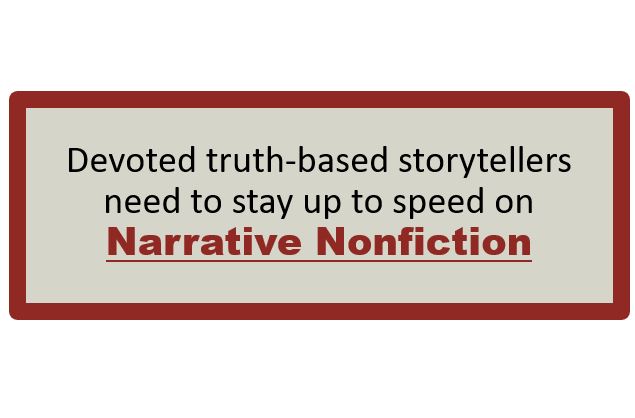Narrative nonfiction is the primary genre of my writing, so I worked to tease out a fuller understanding. Nobody sold me on this; it’s what I was buying (i.e., it is the way I write). The analyst in me prompts me to write about it as I explore. So, here are my learnings.
First, this aside: nonfiction gets a bit of a bad rap. Some perceive it as too constraining and structured, maybe even a bit less fun. Narrative nonfiction can help you break through all such poppycock and it can be quite rewarding. How can we better bolster and support the nonfiction community?
That said, be prepared to inform and entertain readers in a distinct and powerful way. While genres are never “carved in stone,” this one has been most succinctly labeled as “true stories, well told.”1 It springs from the living of life.
The Essential Characteristics
Narrative nonfiction merges factual reporting with literary techniques to tell a true story. It combines truth with elements of fiction like scene setting, natural dialogue reflecting intimacy with the characters, narrative arc, to tell a true story. So, it is a hybrid that requires discipline and skills attendant to both journalism and creative literature.
This approach requires well-rounded characters (real rather than realistic) and a winning story line (of interest, if not also import). Assuming the writer pulls it off while attending to the legal and moral interests all constituents (readers, characters, publishers), it can be powerful and rewarding. Works of this order can take many shapes (think sub-genres), reflect numerous levels of sophistication, and utilize means of delivery from books to a podcast to a Netflix narrative documentary series.
Nonfiction of this type departs from traditional journalism in this regard: it is less singularly focused on objectivity and can lend itself to subjectivity. This is to say facts and experiences can lead to opinions and criticisms that are imparted through the story.
Writers of this type of nonfiction will have more than the usual decisions to make and lines to draw. There is always a balance to strike between imagination and the telling of a story – and the demand is more pronounced here when the story is offered as truth. Herein lie the ethics of the matter. The writer must be fully willing and able to defend his work.
Opinion: this genre is a powerful tool that will always be subjected to manipulation and control, so it needs to be proactively included in responsible first-amendment-related legislation and policy.
In any case, the writer of nonfiction narrative should be attuned to its current socio-political position. Truth is increasingly being assaulted and openly manipulated. Today we experience the social drama of ramped-up literature suppression in America. Simultaneously, we can see that narrative nonfictional work represents a significant portion of the free-expression that is being stifled.
We’ve Gone Through an Important Fifty-Year Tweak
Narrative nonfiction (also called creative nonfiction) has re-emerged in a vibrant modern form. Let’s say “re-emerged” because truth-based stories are as old as the written word.
Call it a tweak, but fundamentally, there has been a necessary and important change in this space. However, the substance of the actual change might seem small in relation to the stiffness of change resistance. The change aligns with keeping the truth alive and accessible, while resistance is manifested in journalistic, literary, and academic communities.
The change started five to six decades ago under the names of The New Journalism and Gonzo Journalism, championed by Tom Wolfe and Hunter Thompson, respectively. Other earlier labels included Creative Nonfiction and Literary Journalism. These are not profoundly different and all contributed. It seems writers ascribed themselves to one or the other depending upon their backgrounds. Other authors making substantial contributions to truth-based story telling include Truman Capote, Gay Talese, and Norman Mailer. Contrast these with Gore Vidal (whom I love), who falls more into literary fiction. StudySmarter provides additional insight into all these dynamics.
Change is a fickle, and it does not come quick or easy to stodgy communities and institutions, especially with the government and technology factored in. The higher the stakes and the tighter the cling to tradition, the more challenging the change, regardless of need or intent. For example, the absence of proactive change (i.e., good governance) in this realm has left social media giants with no responsibility for their user’s postings; essentially everyone is a journalist of a sort, with no rules.
The Jim Sutton Implementation
The bulk of my writing is narrative nonfiction. The flagship piece will be a narrative memoir.
My memoir is also a fit with true crime, which constitutes an influential narrative combo. To be clear, I am the first-person protagonist. The story extends beyond a short but serious crime into punishment and long-term individual and social implications. It is not aggrandizement or forgetful of victims; it is more a vivid description and analysis of how the system doles out justice to a common man, with social commentary and reflections on humanity for others.
1 Lee Gutkind, Hattie Fletcher, True Stories, Well Told, Creative Nonfiction Association, (2014).

